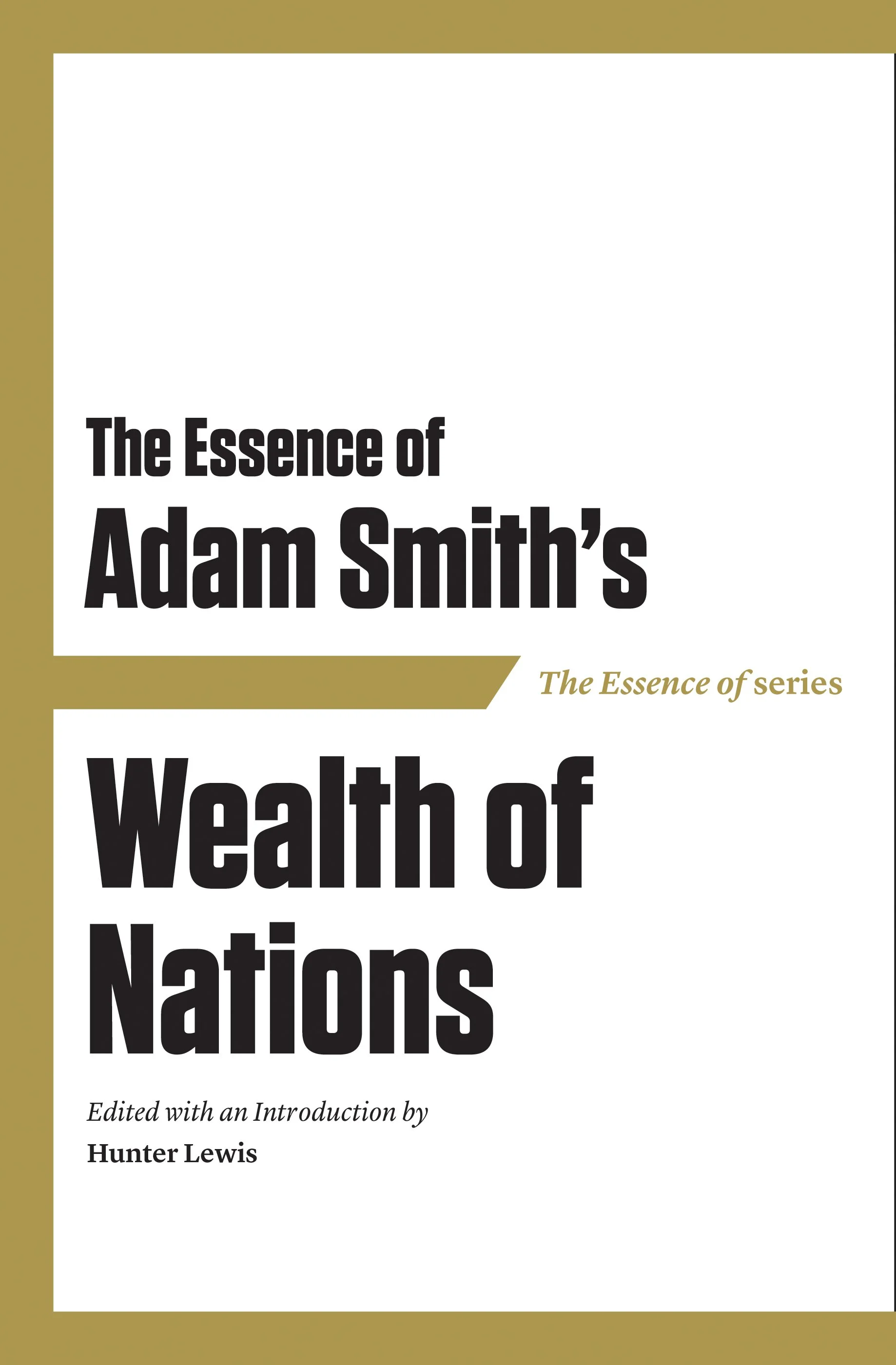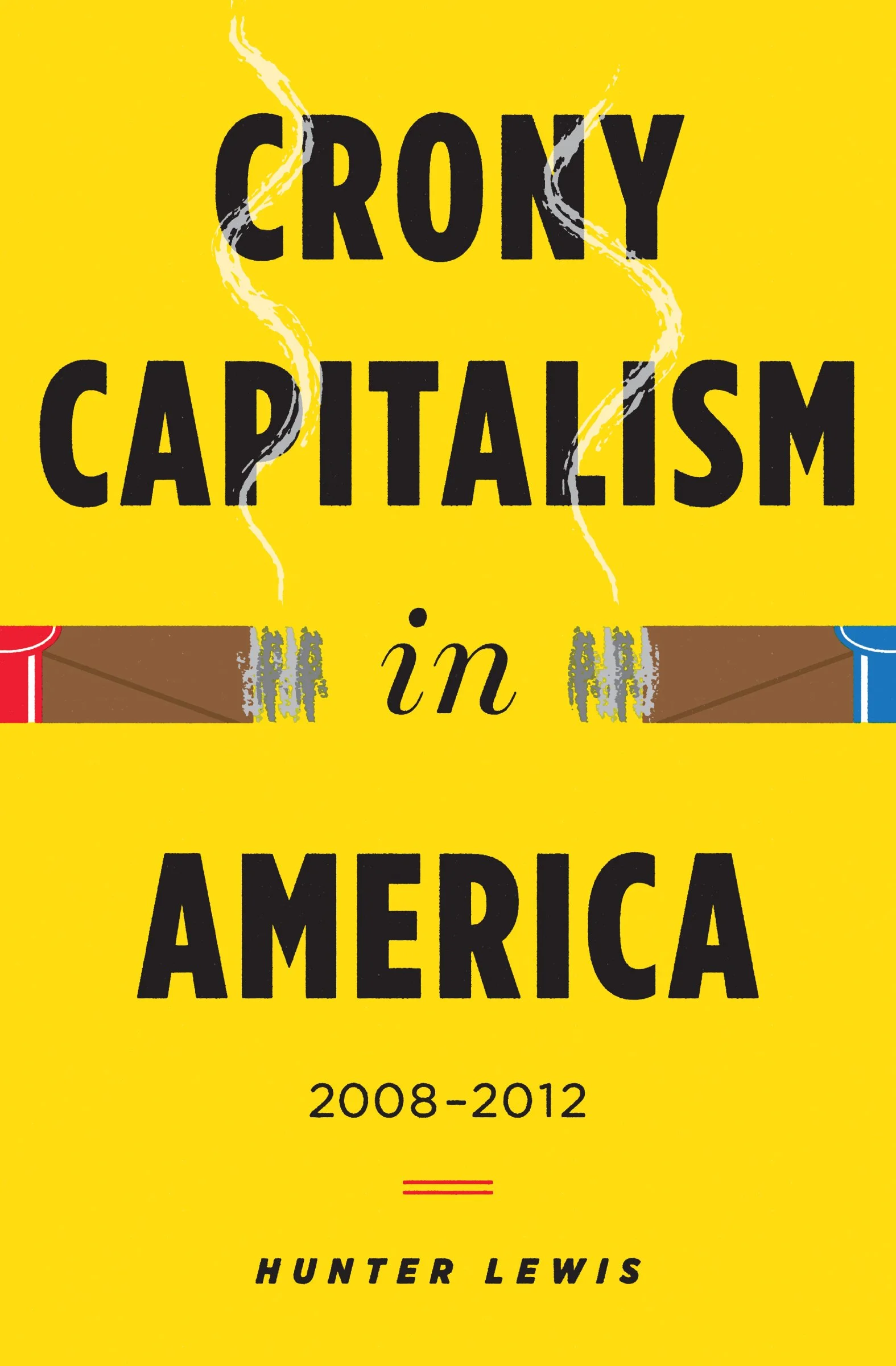Economics in Three Lessons & One Hundred Economic Laws
Author: Hunter Lewis
ISBN: 978-1-60419-114-1
eISBN: 978-1-60419-115-8
Two works in one volume! Together, these works offer readers both a practical guide to understanding real-world economics and a defense against misleading economic arguments.
Available From:
Two works in one volume:
Economics in Three Lessons
Henry Hazlitt’s 1946 book Economics in One Lesson sold more than a million copies. It is perhaps the best selling economics book of all time. In this book, Hunter Lewis, a Hazlitt admirer and student, provides a sequel and update.
The central lesson of Hazlitt’s seminal work is that economic thought and policy must consider all the consequences of an action, not just the immediate or most visible ones. Hazlitt is right that this is the kernel of all good economics. Lewis covers this theme and also introduces two more lessons: how a free and uncontrolled price system creates prosperity and how a controlled or manipulated price system creates only crony capitalist corruption and, ultimately, poverty and economic failure.
The great merit of this work is its brevity and simplicity. Anyone can read and understand it. It is an ideal introduction to economics.
One Hundred Economic Laws
In this groundbreaking work, Lewis does what no one has attempted to do, at least not for many decades. It collects in one place some of the most important laws of economics.
Everyone understands the importance of understanding the laws of physics and other natural sciences. Are there also laws of economics? Can understanding them also make our lives better? Lewis answers with a resounding yes to both questions.
We need the laws of economics to help guide our choices and actions in a very uncertain world. We also need them to protect us from the “thinkers for hire” who, paid by special economic interests, try to persuade us to ignore reality.
This short work is also a complete course in economics. Unlike the dry-as-dust and often irrelevant textbooks forced on high school and college students, it is written in a lively style.
Overview
-
ECONOMICS IN THREE LESSONS
Lesson One: Sustainability
1: Henry Hazlitt’s Invaluable Insight
Lesson Two: The Free Price System
2: The Central Role Played by Free Prices
3: What Prices Do for Us
4: The Role of Profits in Driving Down Prices
5: Who Are the Bosses in a Free Price System?
6: “Spontaneous Order” from Free Prices
7: The Essential Role of Loss and Bankruptcy
8: What About Inequality?
9: Why Greed Is Not “Good” in a Free Price System
Lesson Three: Enemies of the Free Price System
10: Crony Capitalism
11: Laissez-Faire Contra the Cronies
12: Today’s Crony Capitalism
13: The Crony Capitalist Conundrum
14: The Progressive Paradox
15: Where Does This Leave the Poor?
16: How the Fed Fits In
17: The Fed’s Conflict of Interest
18: Who Exactly Is Feeding off the Fed?
19: Keynes’s General Theory: The Crony Bible
20: Saying Goodbye to Crony Capitalism
Endnotes
_________
ONE HUNDRED ECONOMIC LAWS
Preface
I: Laws of Economic Analysis
Law of Analytic Laws
Corollary A of Law of Analytic Laws: Material Life
Corollary B of Law of Analytic Laws: Boundaries
Corollary C of Law of Analytic Laws: Physical Science Myopia
Corollary D of Law of Analytic Laws: Logic
Corollary E of Law of Analytic Laws: Mathematics
Corollary F of Law of Analytic Laws: Economic Data
Corollary G of Law of Analytic Laws: Predicting the Future
Corollary H of Law of Analytic Laws: Immutability
Corollary I of Law of Analytic Laws: Universality
Corollary J of Law of Analytic Laws: Corruption
II: Laws of Economic Sustainability
Law of Sustainability
Corollary A of Law of Sustainability: Unintended Consequences
III: Laws of the Division of Labor
Law of the Division of Labor
Corollary A of Law of the Division of Labor: Voluntary Exchange
Corollary B of Law of the Division of Labor: Private Ownership
Corollary C of Law of the Division of Labor: (Law of) Potential Diseconomies of Scale
Corollary D of Law of the Division of Labor: (Law of) Diminishing Returns
Corollary E of Law of the Division of Labor: (Law of) Potential Economies of Scale
Corollary F of Law of the Division of Labor: (Law of) Comparative Advantage, also called Law of Shared Advantage
Corollary G of Law of the Division of Labor: (Law of) Absolute Advantage
Corollary H of Law of the Division of Labor: Deceptive Trade Practices
Corollary I of Law of the Division of Labor: Scale of Participation
IV: Laws of Prices
Law of Prices
Corollary A of Law of Prices: (Law of) Discovery and Communication
Corollary B of Law of Prices: (Law of) Order
Corollary C of Law of Prices: Honest Prices
Corollary D of Law of Prices: (Law of) Supply
Corollary E of Law of Prices: (Law of) Demand
Corollary F of Law of Prices: (Law of) Supply and Demand
Corollary G of Law of Prices: (Law of) One Price
Corollary H of Law of Prices: (Law of) Marginal Utility
Corollary I of Law of Prices: Monopoly
V: Laws of Profits
Law of Profits
Corollary A of Law of Profits: Consumer Control
Corollary B of Law of Profits: Patience
Corollary C of Law of Profits: “Speculation”
Corollary D of Law of Profits: Loss and Bankruptcy
Corollary E of Law of Profits: Change
Corollary F of Law of Profits: Changing Ideas
Corollary G of Law of Profits: “Frictional” Unemployment
VI: Laws of Profits and Wages
Law of Profits and Wages
Corollary A of Law of Profits and Wages: Union Wage Gains
Corollary B of Law of Profits and Wages: Mandated Wage Floors or Gains
Corollary C of Law of Profits and Wages: Say’s Law of Supply and Demand
Corollary D of Law of Profits and Wages: Balanced Prices
Corollary E of Law of Profits and Wages: Wage Ceilings
VII: Laws of Economic Equality and Inequality
Law of Economic Equality and Inequality
Corollary A of Law of Economic Equality and Inequality: The Problem of Envy
Corollary B of Law of Economic Equality and Inequality: Inequality “Data” and Its Interpreters
Corollary C of Law of Economic Equality and Inequality: Greed and Conspicuous Consumption
Corollary D of Law of Economic Equality and Inequality: The “Trickle Down” Fallacy
Corollary E of Law of Economic Equality and Inequality: Wealth Taxes
Corollary F of Law of Economic Equality and Inequality: Wealth “Redistribution”
Corollary G of Law of Economic Equality and Inequality: Making the Worker the Boss
VIII: Laws of the Division of Labor within the Free Price System
Summary Law of the Division of Labor within the Free Price System
Corollary A of Summary Law of the Division of Labor within the Free Price System: Competition within an Overall System of Cooperation
Corollary B of Summary Law of the Division of Labor within the Free Price System: Growing Networks
Corollary C of Summary Law of the Division of Labor within the Free Price System: Worldliness Redefined
Corollary D of Summary Law of the Division of Labor within the Free Price System: Nation Size
Corollary E of Summary Law of the Division of Labor within the Free Price System: Individualism and Cooperatism
Corollary F of Summary Law of the Division of Labor within the Free Price System: World Governments Today
IX: Laws of Economic Calculation
Law of Economic Calculation
Corollary A of Law of Economic Calculation: Measuring Change
Corollary B of Economic Calculation: Limits of Calculation
Corollary C of Law of Economic Calculation: Externalities
X: Laws of Economic Calculation outside Business
Law of Economic Calculation outside Business
Corollary A of Law of Economic Calculation outside Business: “Borrowed Prices”
Corollary B of Law of Economic Calculation outside Business: Halfway Houses between Socialism and a Free Price System
XI: Economic Law of Government
Summary Economic Law of Government
XII: Laws of Money
Law of Money
Corollary A of Law of Money: Gold
Corollary B of Law of Money: Gresham’s Law
Corollary C of Law of Money: “Paper” Money
Corollary D of Law of Money: “Paper” Money and Inflation
Corollary E of Law of Money: (Law of) Diversification
Corollary F of Law of Money: (Law of) Investment Value
XIII: Laws of Money Prices
Law of Money Prices
Corollary A of Law of Money Prices: Stabilizing Prices
Corollary B of Law of Money Prices: Measuring Prices
Corollary C of Law of Money Prices: “Elastic” Money Supply
Corollary D of Law of Money Prices: Real Wealth
Corollary E of Law of Money Prices: Deflation
Corollary F of Law of Money Prices: Inflation (Roots of)
XIV: Law of Interest Rates .309
Law of Interest Rates (on Money Loans)
XV: Laws of Banking
Law of Banking
Corollary A of Law of Banking: Fractional Reserves Create Money
Corollary B of Law of Banking: The Federal Reserve
Corollary C of Law of Banking: Fed as Price Fixer
Corollary D of Law of Banking: Reform
Corollary E of Law of Banking: Bank Privatization
XVI: Laws of Government-Controlled Banking
Law of Government-Controlled Banking
Corollary A of Law of Government- Controlled Banking: Government Financing Options 101
XVII: Laws of Spending Versus Saving
Law of Spending Versus Saving (Law of Fiscal “Stimulus”)
Corollary A of Law of Spending Versus Saving: “Fiscal Stimulus”
Corollary B of Law of Spending Versus Saving: Keynesian Financing “Tricks”
XVIII: Law of the Non-Neutrality of Money
Law of the Non-Neutrality of Money
XIX: Law of the Non-Neutrality of Money, Newly Created Money, “Business Cycles,” and Depressions
Law of the Non-Neutrality of Money, Newly Created Money, “Business Cycles,” and Depressions
XX: Summary Laws of Economics
Summary Law of Economics
Corollary A of Summary Law of Economics
Appendix: Summary List of One Hundred Laws
Endnotes
Index for Economics in Three Lessons
Index for One Hundred Economic Laws
-
ISBN-13: 9781604191141
Publication date: 10/07/2017
Pages: 403
Product dimensions: 5.59(w) x 8.32(h) x 1.26(d)
-
“5 out of 5 stars: Nice easy introduction to economic thinking.
Nice easy introduction to economic thinking, inspired by Henry Hazlitt’s magnificent Economics in One Lesson. While Hazlitt’s examples are dated, Lewis uses a modern context that gets his point across very effectively. Every high school student should be required to read this, or something like it.”
Laurence Siegel | Amazon Review (November 13, 2017)
Reviews
“Former global investment firm CEO Hunter Lewis tackles contemporary economics in his two-part book. It distills the topic into three understandable lessons, followed by one hundred “economic laws” that the author hopes can be used “to guide our actions and choices in an uncertain world. . . . This material is an education unto itself . . . and . . . deftly illuminates a subject that is too often maligned and misunderstood.
Barry Silverstein | ForeWord Reviews (September/October 2017)
“An excellent short introduction to the subject. Well worth reading. A nice expansion and update of Henry Hazlitt's Economics in One Lesson. The author provides many simple, easy to understand examples that highlight the points he is making. It would make a great supplement to today's economics textbooks.”
Robert W. McGee | Amazon Review (October 1, 2017)
-
“The author of this book, Hunter Lewis, is the co-founder and former CEO of the global investment firm Cambridge Associates, LLC. He is also the co-inventor of what became known as the American University style of institutional investing. Lewis has written for the New York Times, The Times of London, the Washington Post, and the Atlantic Monthly. His Economics in Three Lessons is a “sequel” to Henry Hazlitt’s classic Economics in One Lesson, a 1946 book about free-market economics. The one lesson in Hazlitt’s book is as follows: “The art of economics consists in looking not merely at the immediate but at the longer effects of any act or policy; it consists in tracing the consequences of that policy not merely for one group but for all groups.” Lewis espouses a similar philosophy in his book, but refines it to three lessons. He also describes 100 laws that follow from these lessons, with 80 of those laws actually being corollaries of only 20 laws.
The first of the three lessons is titled “Sustainability.” Much of the single chapter devoted to this lesson is a long quotation from Hazlitt’s book, including the quote cited above, and reflects what Lewis means by sustainability. In this long passage, Hazlitt discussed public works, stating that some of them (e.g., police and fire departments) are necessary, but that public works used primarily as a means of providing employment (such as those established during FDR’s New Deal) are of little or no value. For every public sector job created by such public works, argued Hazlitt, a private sector job is destroyed somewhere else. Hazlitt’s long quotation emphasizes the importance of thinking long term rather than short term. The author writes that this difference is what separates good and bad economics. Without naming any names, he states that there are supposedly brilliant economists who, citing John Maynard Keynes’ statement that “in the long run, we are all dead,” deprecate savings and recommend massive government spending. But Hazlitt warns that there will ultimately be dire consequences from this short-term thinking, and, even if these consequences do not affect us, they will affect our children and future generations.
The book’s second lesson is titled “The free price system.” In laying out this lesson, Lewis states that “the most reliable barometer of economic honesty is to be found in prices.” Any attempts to manipulate or control prices, claims the author, will end up in failure, because the economy will not be able to function properly. In fact, such efforts have often ended up hurting the very groups they were intended to help. More than once Lewis cites an example from 18th century France. At the time, wheat shortages in the country had driven the price of bread higher, so the peasantry was struggling to afford the cost. In response, the French government placed price controls on bread. Realizing that they would now have to sell their wheat at a loss, farmers stopped planting, and the price of bread rose even higher. According to Lewis, we now know that, just like the French regulatory intervention, government price controls do not work. Imagine government officials trying to figure out what the prices of all the commodities and services in a country’s economy should be. Wouldn’t it be much easier and better just to let a free market determine what these prices should be by the efficient allocation of capital and labor?
We hear so much these days about income and wealth inequality and how important it is to reduce inequality through wealth redistribution. Lewis claims that any government-led effort of this kind will ultimately be a failure. Wealth is not the product of a zero-sum game in which the gain of some people has to be balanced by the loss of others. Rather, it is created through hard work and investment, and it is possible for all segments of society to benefit from such creation. To reinforce this view, Lewis quotes the well-known economist Milton Friedman: “Nowhere is the gap between rich and poor wider, nowhere are the rich richer and the poor poorer, than in those countries that do not permit the free market to operate.”
The third lesson presented in the book is titled “Enemies of the free price system.” Lewis dedicates a few chapters to discussing and denouncing “crony capitalism,” another term that has appeared frequently in recent media coverage. Crony capitalism is an economic system characterized by close, mutually advantageous relationships between business leaders and government officials. One particular example Lewis cites is President Barack Obama’s stimulus bill of 2009. This bill provided for an $800 billion stimulus that was intended to revive the economy, which had been devastated by the collapse of some investment firms and the near-collapse of the housing market and several banks. Lewis claims that much of the money went to select state and local governments and private-interest donors such as the green energy company Solyndra. The “cash for clunkers” program, designed to encourage consumer spending on more fuel-efficient vehicles, was another government program that turned out to be ineffective. The point Lewis aims to convey is that regulations on business have their place, but they should be kept to a minimum.
The second part of the book is devoted to Lewis’s 100 economic laws (counting the 80 corollaries). Of the 20 key laws in the compendium, three in particular seem to conform most closely to the three economic lessons. The first of these is the Law of Prices, which states that “if we wish to cooperate on a voluntary basis, we must have shared, workable, flexible prices.” In discussing this law, Lewis uses a quote from Matt Ridley’s book Genome: “The illusion that economies run better if someone is put in charge of them has done devastating harm to the wealth and health of peoples all over the world, not just in the former Soviet Union, but in the West as well.” The second law is the Law of Profit and Wages. Many people today rail against companies that they claim make “obscene profits.” However, Lewis claims that any government action to restrict profits in a particular industry will decrease the number of companies willing to engage in that industry, thereby reducing supply and most likely increasing prices—a result contrary to the one intended. Moreover, because companies compete in a free market, their primary way of increasing profits is to become more efficient and cut costs. The final law that Lewis emphasizes is the Law of the Non-Neutrality of Money, which suggests that “injecting new money into the economy from any source…by definition cannot be neutral,” that is, it will favor some groups over others. Thus, Lewis opposes any type of fiscal stimulus program, even the “quantitative easing” that Federal Reserve chairman Ben Bernanke put in place after the 2007–09 financial crisis. To sum up the 100 laws into one, Lewis writes that “if you want a thriving economy, protect free and flexible prices.”
The book advocates policies that few, if any, governments, foreign or domestic, have followed faithfully. However, evidence that these policies actually work can be found in the historical experiences of Singapore and South Korea. Although these countries were quite poor 60 years ago, today they are very prosperous, with per capita income in Singapore being higher than that in the United States. This transformation occurred primarily because both countries became bastions of free trade and free markets. Whether in agreement with Lewis’s economic philosophy or not, readers will find his arguments compelling and worthy of debate.”
Ronald Johnson, Monthly Labor Review, U.S. Bureau of Labor Statistics (February 2018)
Related Reading
About the Author
Hunter Lewis
Hunter Lewis is co-founder and former CEO of global investment firm Cambridge Associates, LLC and author of 12 books on economics and moral philosophy. He has contributed to the New York Times, the Times of London, the Washington Post, and the Atlantic Monthly, as well as numerous websites such as Forbes.com, RealClearMarkets.com, and many others. He has served on boards and committees of fifteen leading not-for-profit organizations, including environmental, teaching, research, and cultural organizations, as well as the World Bank.
Interviews & Podcasts
Listen to interviews with author Hunter Lewis
Kevin Price, Price of Business Radio (January 9, 2018):
Hunter Lewis – New Book: Economics in Three Lessons & One Hundred Economic Laws
“I consider it must reading.” - Host Kevin Price
Bill Martinez Live (October 23, 2017):
Hunter Lewis – Economics in Three Lessons, and will President Trump’s Tax Plan really help the middle class.
The Chad Benson Show (October 4, 2017):
Hunter Lewis, economist and co-founder of Cambridge Associates, talks about economics and economic laws.
The Tom Woods Show (December 1, 2017): Ep. 1051 Want to Be Poorer? Defy These Economic Laws
Hunter Lewis, in an amazing book called Economics in Three Lessons & One Hundred Economic Laws, concisely reviews the crucial economic ideas that can help people see the world in a whole new way.
“An amazing book.” - Host Tom Woods
Fox Business (October 6, 2017): Varney & Co.
Is a big market correction coming?









